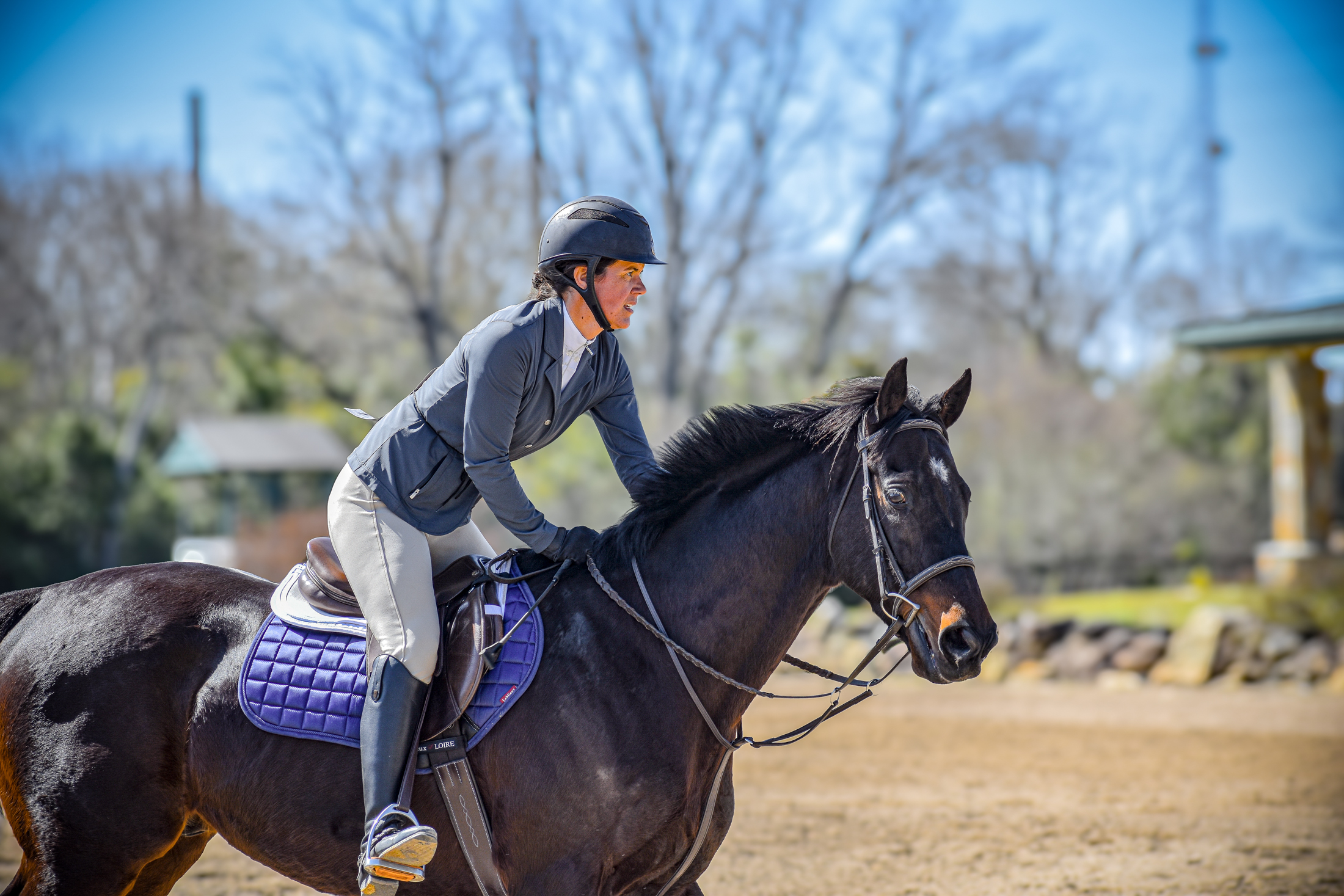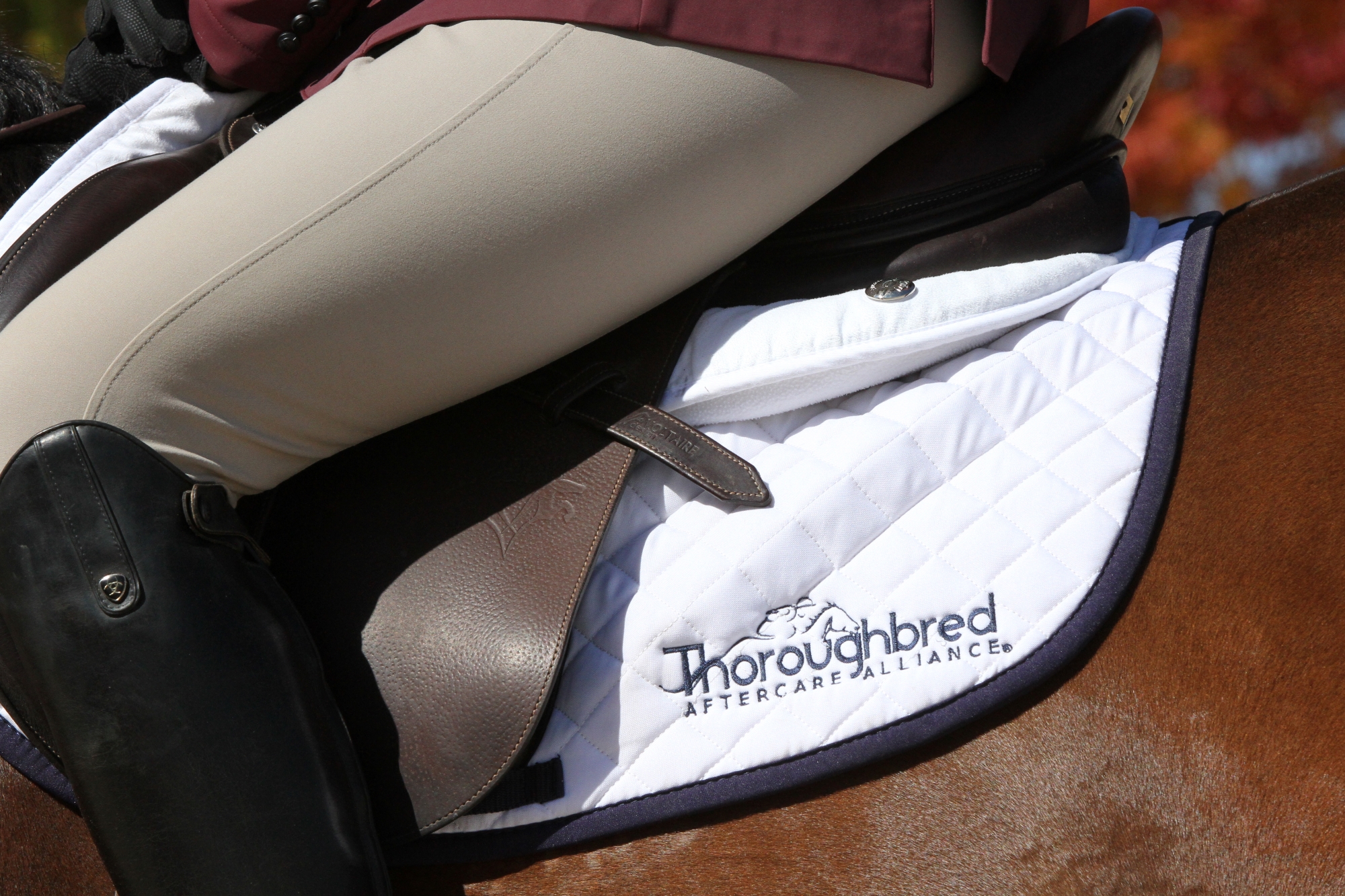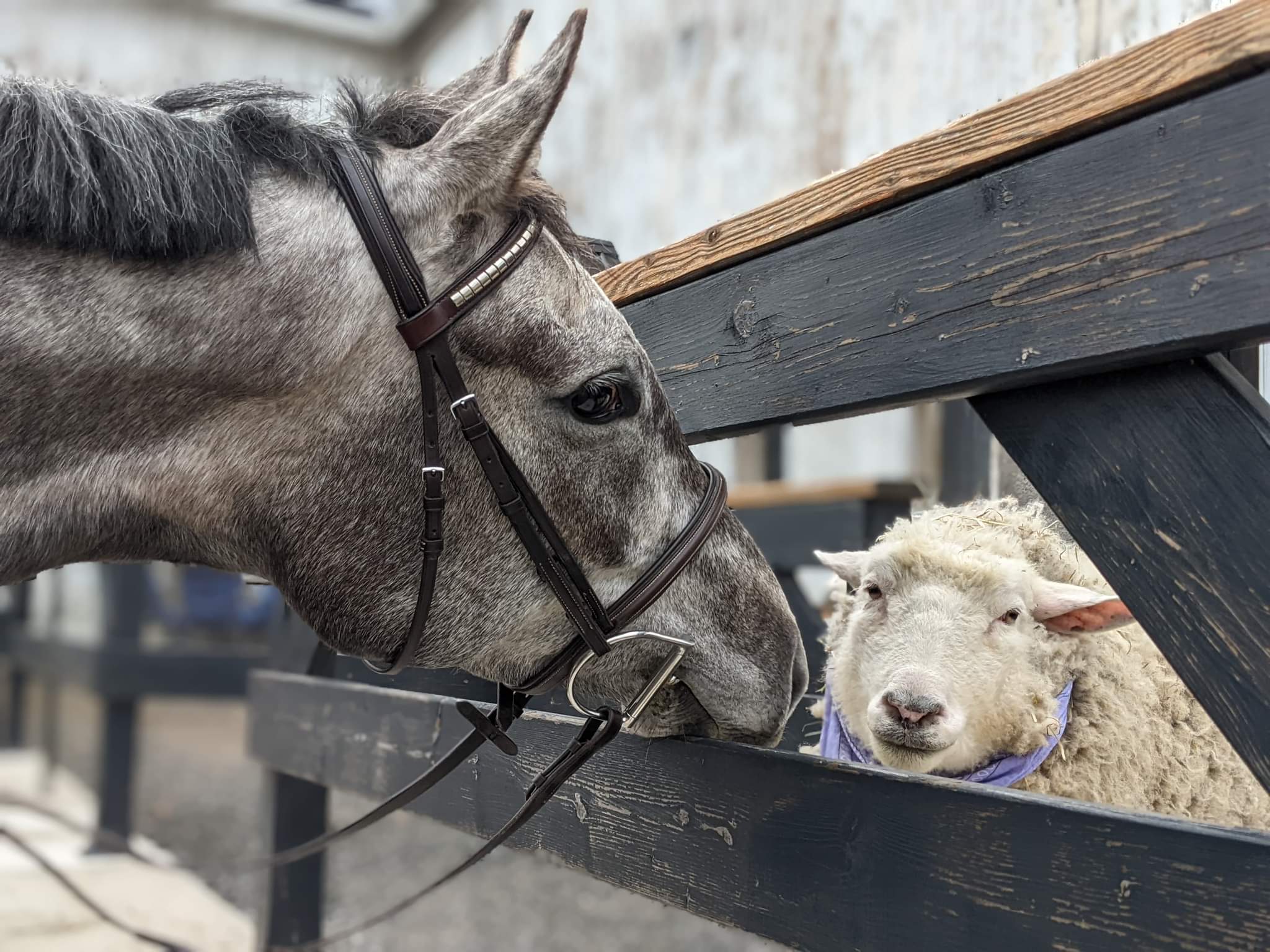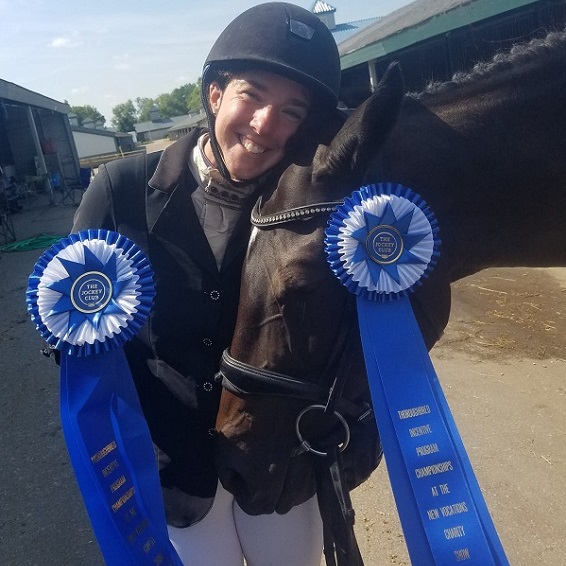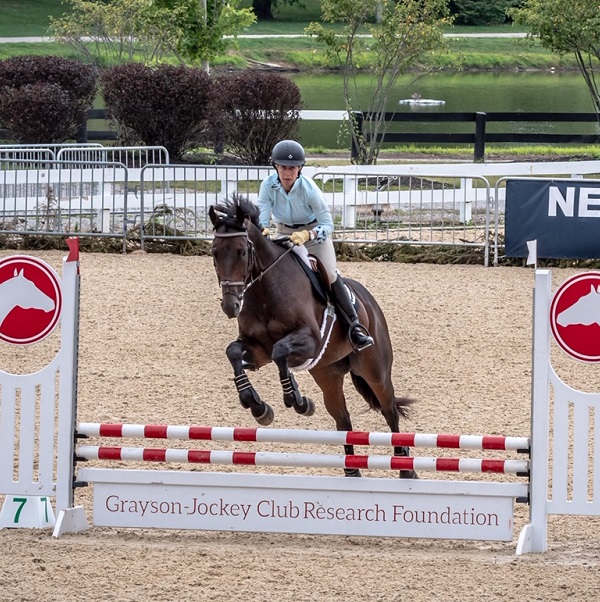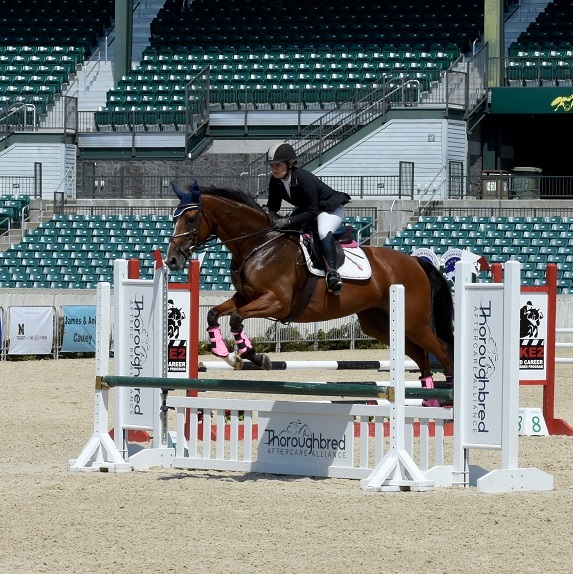jumper
All Posts & News Press Releases Success Stories Aftercare Editorials Retraining Tips Supporter Features Inspector Spotlights Previous PostNext Post Cambi Lion: A Racehorse’s Journey to the Hunter Jumper World Cambi Lion: A Racehorse’s Journey to the Hunter Jumper World By: Alexis Arbaugh June 7, 2024 Success Stories Tags:hunter jumper, jumper, New Vocations Racehorse Adoption Program, Retraining Story, Success story Chelsea Whalen previously had some experience training and retraining horses but had never worked with an off-the-track Thoroughbred. She embraced the challenge of transitioning a former racehorse into a Hunter Jumper. Chelsea found her perfect match at New Vocations Racehorse Adoption Program. Many of the horses that go to New Vocations are put into a retraining program for a new discipline when they arrive. Chelsea had a list of specific criteria for her potential horse. She sought a horse under 5 years old with clean x-rays, “a horse who was more uphill,” and one with a graceful gait. She was able to check everything off her list when she was introduced to Cambi Lion, a 2018 Medaglia d’Oro. He had raced only a few times, with five starts but some substantial earnings in his short career, having raced at Saratoga, Belmont Park, and Gulfstream Park. He was stunning—a tall, dark bay gelding who looked like the perfect candidate to become Chelsea’s new partner. After unloading from a quiet trailer ride, Chelsea settled him into his new stall to acquaint him with his surroundings. This allowed him to look around the barn and see other horses while being safely confined to a stall. Following his initial settling-in period, Chelsea took him for a walk around the property, allowing him to familiarize himself with the entire barn and its surrounding area. Over the first week or so that Cambi Lion was at the farm, he progressed to being turned out with other horses and settled into his new night turnout routine. Unfortunately, Cambi Lion had a broken splint bone and needed to be on stall rest for about two months before Chelsea could start working with him. Once the two months were up and he was fully healed, Chelsea began the retraining process, both in the saddle and on the ground. Under-saddle work represents half of the challenge in training a horse; the other half lies in groundwork. Despite Cambi Lion’s familiarity with various handling tasks, it remained crucial to consistently work on ground manners to ensure continued good behavior. Thanks to Chelsea’s continuous effort, Cambi Lion now has excellent ground manners and tolerates many situations. Although most horses typically begin with lunge line training before starting under saddle work, Chelsea’s vet recommended skipping this step and proceeding directly to riding. The recommendation was based on Cambi’s a broken splint bone, with the vet believing that lunging would put more strain on the bone compared to riding. Additionally, since Cambi was on stall rest, Chelsea would have more control of him under saddle than on a lunge line. During the initial weeks, she focused heavily on pressure and release techniques, primarily centered around prompting Cambi Lion to respond to her leg aids. “The start of the retraining process begins with riding on the flat,” wrote Chelsea. Retired racehorses also require instruction on how to respond to rein cues for steering within a new discipline, a skill that often needs perfecting after a horse comes off the track. Chelsea began teaching Cambi Lion that the reins served as a means to guide him in the desired direction, hoping he would catch on quickly. While Chelsea couldn’t pinpoint a specific moment when she felt Cambi Lion was ready to start jumping, she vividly recalls the methodical approach she took in preparing him. “Arguably, I started training for jumping disciplines as soon as I began riding,” wrote Chelsea. Their journey began with practicing over ground poles and then building from there. Ground poles are a great way to get a horse used to going over something and to learn not to get nervous or anxious about it. As his “confidence grew and his strength improved,” Chelsea then worked with small jumps and continued to raise the height. When Cambi Lion was ready, he was able to cruise around small courses without a problem. Jumping quickly became enjoyable for Cambi Lion, showcasing both his enthusiasm and natural talent for his new sport. SEE RELATED RE-TRAINING TIP FEATURE: “How to Teach Your Retired Racehorse to Jump” Click HERE for Retraining Tip Feature Retraining an off-the-track Thoroughbred demands significant effort and patience, even for the most seasoned trainer. Chelsea had the honor of working with a close training friend of hers, Freda Jessen. Freda, having worked with numerous ex-racers throughout her career, was an experienced trainer in seamlessly transitioning OTTBs to new careers. In addition to Freda’s guidance, Chelsea had assistance from another trainer friend, whose expertise further facilitated Cambi Lion’s progression into the hunter/jumper world. Given the dangerous nature of training a horse alone, it is safer and easier to work with someone who has a background in it. Cambi Lion was doing so well that Chelsea decided to take him to his first horse show just three months into his retraining. She hadn’t initially intended to show him; rather, she brought him along to acclimate him to the atmosphere of a horse show. Impressed by Cambi Lion’s exceptional calmness, Chelsea decided to enter him in his very first flat class. Cambi Lion remained remarkably composed while at the show and in the show ring. After approximately five months of dedicated training, Cambi Lion entered his first real jumping competition. Chelsea was confident in his ability to both behave and perform well. Observing Cambi Lion’s growing confidence at home over jumps and his increasing comfort with off-site adventures, Chelsea recognized that he was ready to begin his show horse career. Share This Article Do you have a success story that you would like to share? Submit your experience with an accredited organization here: Success Story Submission
Read More >All Posts & News Press Releases Success Stories Aftercare Editorials Retraining Tips Supporter Features Inspector Spotlights Previous Post How to Teach Your Retired Racehorse to Jump How to Teach Your Retired Racehorse to Jump By: Alexis Arbaugh June 6, 2024 Retraining Tags:Friends of Ferdinand, hunter jumper, hunters, jumper, jumpers, Jumping, Retraining Tips, show jumping Alien Invasion – Photo provided by Lori Miller Lori Miller, Friends of Ferdinand Many people who adopt a Thoroughbred after it is retired from racing hope to train their horse for a second career, often in disciplines that involve jumping. Training a Thoroughbred to jump can be a brand-new experience for these retired athletes, as racehorses—unless experienced in steeplechase—don’t engage in jumping or even handling poles. Their primary focus is running on the flat and being trained for speed. Therefore, it can be challenging to teach an off-the-track Thoroughbred how to carefully and skillfully navigate a course of jumps. Lori Miller is the head trainer at Friends of Ferdinand, an organization accredited by Thoroughbred Aftercare Alliance. Located in Indianapolis, Indiana, Friends of Ferdinand specializes in retraining, rehabilitation, adoption, and providing sanctuary homes for Thoroughbreds retired from racing. Lori has extensive experience with racetracks and retired racehorses and takes pleasure in the retraining process, knowing that racehorses can have happy and healthy lives in new careers. Lori’s wealth of experience and knowledge makes her the perfect person to help fellow adopters navigate their new horse’s retraining process. It is difficult to determine if a horse will be a good jumper just by looking at them, as there are many factors to consider and different contexts for evaluation. “If you are at the track, it’s tough. A horse that races in blinkers or wears a shadow roll might be one that has a lot to think about,” Lori wrote. Horses that need to wear blinkers to focus generally have excess energy and are spooky. Lori generally tries to avoid spooky horses because it creates more problems when teaching them to jump. “I prefer the horses that will walk with confidence through whatever,” Lori wrote. Lori also considers conformation when assessing whether a horse would be good at jumping. She likes horses that seem to float when they travel, rather than stomp. She avoids horses with crooked legs, tiny feet, or a downhill build. Instead, she looks for horses that are balanced with an uphill build and correct angles. She prefers straight legs that allow the horse to stand under themselves and a neck that ties in high to their shoulders. Although there are outliers—horses with unconventional conformation that make wonderful jumpers—they are few and far between. A horse with a good attitude is always easier to work with than one that is grumpy or has a poor attitude. When asked about the kind of attitude or temperament she looks for, Lori replied that she seeks “the horse that wants to work with you, the horse that looks to the person rather than away”. A horse that wants to learn and seeks guidance from people is always going to excel. However, it is easier to evaluate a horse’s willingness after they have had a chance to settle down on a farm following their racing career. It usually takes some time after leaving the track for a horse to come out of its shell and show its true personality. “How they are at the track is frequently very different than they are away from home,” Lori wrote. Any horse that is friendly and easy to work with and around is a good start. “I want the horse to learn to go over what is put in front of it. Systematically by never asking it to do something we haven’t built up to. Teaching the horse to stay in a rhythm and not run, that there is no reason to get tight and anxious. I want my horses to learn it’s all positive”. Lori Miller Friends of Ferdinand So, now that you have your horse, how do you start jumping? Lori begins with basic flat work to ensure the horse is supple and responsive to the bit. She encourages the horse to move forward off the leg and be quick and accurate with transitions, ensuring the horse is always listening. After establishing a strong flat foundation, she introduces poles on the ground, having the horse casually walk, trot, and canter over them until they are no longer an issue. She wants the horse to get used to riding around standards, poles, and jumps in the arena, encouraging them to watch and continue working. When Lori feels the horse is ready to jump, she starts with a small jump that the horse can easily walk over. If the horse stops in front of the jump, she breaks it down to make it more inviting. “Slow work to build a confident horse,” Lori wrote. By this point, the horse is accustomed to going over poles and small boxes, so a small cross rail shouldn’t be a big deal. Their first actual jump might be a cross rail or a small log in the field, and the horse shouldn’t be fazed by it. Desensitizing your horse to various obstacles helps prevent stress or nervousness about jumping. When asked what Lori would like the horse to take away from their first jumping experience, she replied, “I want the horse to learn to go over what is put in front of it. Systematically by never asking it to do something we haven’t built up to. Teaching the horse to stay in a rhythm and not run, that there is no reason to get tight and anxious. I want my horses to learn it’s all positive”. Lori often trots over fences in the beginning stages of teaching a horse to jump. This allows the horse to learn to make a shape and stay straight while building confidence at a slower and more balanced pace. She advises against over-jumping young horses or those learning to jump, limiting
Read More >All Posts & News Press Releases Success Stories Aftercare Editorials Supporter Features Inspector Spotlights Previous Post Andrea and Britta’s Journey Andrea and Britta’s Journey By: Alexis Arbaugh May 3, 2024 Success Stories Tags:dressage, hunter, hunter jumper, jumper, LongRun, LongRun Thoroughbred Retirement Society Andrea McGowan adopted her first LongRun Thoroughbred Retirement Society graduate in 2010. The organization was recommended to her by a friend, who exercised racehorses at Woodbine, as being a trusted source for horse adoption. Creemore was Andrea’s equine partner for 11 years before his well-deserved retirement in 2021. After retiring Creemore, Andrea knew where to look for her next horse. “There was no question of where I’d find my next partner in crime,” Andrea declared. Rule the Sea, now known as Britania or Britta for short, raced 7 times at Woodbine Racetrack and Fort Erie Racetrack from 2020 to 2021, earning a total of $6,794. She was just a couple of days off the track when Andrea rode her for the first time at LongRun. “It was just about love at first sight,” wrote Andrea. Britta was all business, seemingly unbothered by the pigeons that flew around in the area. “She just put her feet down in such a confident, classy way,” Andrea said. Andrea quickly recognized Britta as the smartest and quickest horse she has ever had the pleasure of riding. The pair progressed rapidly in their training. They competed in their first Hunter/Jumper show just 18 months after Britta’s adoption, pinning in every class they entered. “In her first Jumper class, she turned and burned like a pro,” Andrea remarked. Soon after their successful first show, they tried their hand at short-course Eventing. Andrea has big goals for herself and Britta, but most importantly, she wants to enjoy every second that they have together. Her ultimate goal is to have as many wonderful adventurous years with Britta as she did with Creemore. “I look forward to Britta becoming a great all-rounder,” Andrea shared. She hopes to continue to progress in Dressage, participate in lots of clinics, and continue to show in the Jumpers. Andrea expressed, “I’m so grateful to Longrun and the Thoroughbred Aftercare Alliance for giving these superb athletes the chance to shine in their post-racing life.” Share This Article Do you have a success story that you would like to share? Submit your experience with an accredited organization here: Success Story Submission
Read More >Little Latin Lulu ran three times, never breaking her maiden, before being retired to Maker’s Mark Secretariat Center by her connections.
Read More >The Mike Maker trainee earned just more than $383,000 and won the 2017 West Virginia House of Delegates Speaker’s Cup Stakes, but now his strong work ethic is proving useful in the jumper arena.
Read More >The New Vocations All-Thoroughbred Charity Show and Thoroughbred Incentive Program Championships held Sept. 6-8, 2019 at the Kentucky Horse Park was a success for TAA grads. TAA-accredited organizations were well represented in numerous disciplines and their horses shined bright competitive classes. The TAA presented High Point awards in four disciplines: dressage, hunter, jumper, and pleasure. Dressage: Little Latin Lulu and Kara Hertz Hertz adopted Little Latin Lulu from the Maker’s Mark Secretariat Center in May of 2019. The duo earned first place in both the Intro test A adult amateur and Intro test B adult amateur with scores of 70% and 68%. There were 10 horses from four TAA-accredited organizations competing for the TAA Dressage High Point Award. Hunter: Big City Dancer and Sue Sylvester Sylvester adopted Big City Dancer from the Maker’s Mark Secretariat Center in 2012. There were 22 horses from nine TAA-accredited organizations competing for the TAA Hunter High Point Award. Jumper: Kulik Lodge and Taylor Wienold Brooke Schafer adopted Kulik Lodge from the New Vocations Racehorse Adoption Program in October of 2016. There were four horses from three TAA-accredited organizations competing for the TAA Jumper High Point Award. Pleasure: Frank’s Gift and Victoria Kupets Kupets adopted Frank’s Gift from the New Vocations Racehorse Adoption Program in May of 2019. There were four horses from two TAA-accredited organizations competing for the TAA Pleasure High Point Award. In total, 12 TAA-accredited organizations were present at the New Vocations All-Thoroughbred Charity Show and TIP Championships. After the Races Akindale Thoroughbred Rescue Friends of Ferdinand Kentucky Equine Adoption Center Maker’s Mark Secretariat Center MidAtlantic Horse Rescue Inc New Vocations Racehorse Adoption Program Old Friends ReRun, Inc Second Stride, Inc Thoroughbred Retirement Foundation Thoroughbred Retirement Network of Louisiana Congratulations to all of our TAA grads on their success in second careers! Photo: Melissa Bauer-Herzog / Pyrois Media Click here to learn more or sign up for the Thoroughbred Incentive Program.
Read More >





